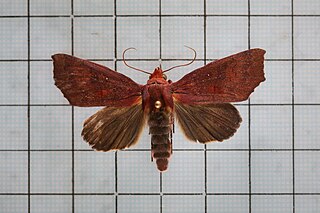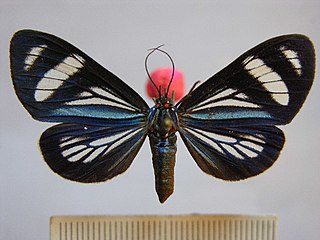Calodesma is a genus of tiger moths in the family Erebidae erected by Jacob Hübner in 1820.

Phalaenophana is a genus of litter moths of the family Erebidae. The species was first described by Augustus Radcliffe Grote in 1873.

Halysidota interlineata is a moth of the family Erebidae first described by Francis Walker in 1855. It is found in Costa Rica, Guatemala, Panama, Belize, Colombia, Venezuela, Suriname, French Guiana, Brazil and Uruguay.

Anomis privata, the hibiscus-leaf caterpillar moth, is a moth of the family Erebidae. The species was first described by Francis Walker in 1865. It is found in China, Taiwan and Japan, but has also been recorded from North America, as most verified sightings have been in the northeastern United States.

Leucanopsis aurantiaca is a moth of the family Erebidae first described by Walter Rothschild in 1909. It is found in Venezuela, Brazil, Costa Rica and Panama.

Hypena conscitalis is a moth of the family Erebidae first described by Francis Walker in 1866. It is found throughout Africa, from Senegal to South Africa, in South and South-East Asia as well as in Australia and on some Pacific and Indian Ocean islands.
Baritius acuminata is a moth of the family Erebidae first described by Francis Walker in 1856. It is found in Brazil, Argentina and Paraguay.
Calodesma approximata is a moth of the family Erebidae. It was described by Hering in 1925. It is found in French Guiana and Colombia.

Calodesma dioptis is a moth of the family Erebidae. It was described by Felder in 1874. It is found in Brazil, French Guiana and Bolivia.
Chrysorabdia viridata is a moth of the subfamily Arctiinae first described by Francis Walker in 1865. It is found in the Indian states of Sikkim and Assam.
Coreura phoenicides is a moth of the subfamily Arctiinae. It was described by Herbert Druce in 1884. It is found in Guatemala and Costa Rica.

Cratoplastis catherinae is a moth of the family Erebidae first described by Walter Rothschild in 1916. It is found in Brazil, Paraguay and Guatemala.

Hypercompe albicornis is a moth of the family Erebidae first described by Augustus Radcliffe Grote in 1865. It is found on Cuba.

Hypocrita bicolora is a moth of the family Erebidae. It was described by Sulzer in 1776. It is found in Panama.
Idalus vitreoides is a moth of the family Erebidae. It was described by Walter Rothschild in 1922. It is known from Trinidad, Costa Rica, and Brazil.

Lampruna rosea is a moth of the subfamily Arctiinae. It was described by Schaus in 1894. It is found in Peru, Colombia, Venezuela, Costa Rica, Guatemala, Panama and Mexico.

Lepidozikania cinerascens is a moth of the family Erebidae first described by Francis Walker in 1855. It is found in Brazil.
Lophocampa niveigutta is a moth of the family Erebidae. It was described by Francis Walker in 1856. It is found in Brazil and Colombia.

Metaxanthia atribasis is a moth of the family Erebidae first described by Walter Rothschild in 1913. It is found in Ecuador, Costa Rica and Panama.
Lophocampa hispaniola is a moth of the family Erebidae. It was described by Vincent in 2009. It is found in the Dominican Republic.












